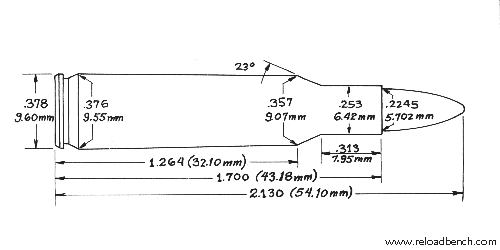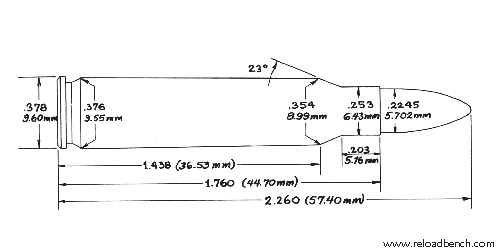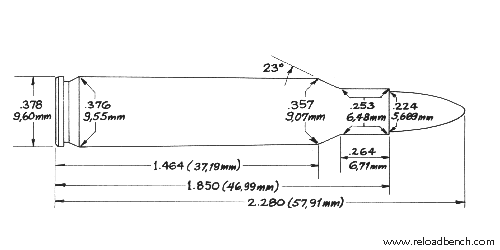| Remington™ .222 / .223 / .222-Mag |
|---|
 .222 RemingtonThe .222 Remington was created by Mike Walker, who also developed the button process for rifling barrels and the Models 721, 722, 40X, and 40XBR rifles. Introduced in 1950 in the Model 722, the .222 couldn't have come along at a better time. Varmint shooters were yearning for a new cartridge and a relatively new game called benchrest shooting was growing in popularity. Within ten years after it was introduced, the .222 was literally dominating both shooting sports.Until the PPC cartridges came along during the mid-1970's, most experienced shooters considered the .222 to be the most inherently accurate cartridge ever to designed. Some still feel that way but the fact remains, few benchrest matches are won today with the .222 Remington. Sadly enough, at the rate old man fate is dealing cards to the .222, it's popularity will probably decline to the point where it enjoys little more limelight than the .222 Remington Magnum. But the .222 Remington had its days of glory and is still tough to beat as a medium range varmint cartridge. A shooter who chooses the .222 over the .223 really isn't giving up as many yards in effective range as many would have us believe. Best bullets for varminting with the .222 are the 50 grain Sierra Blitz, Hornady SX, and Nosler Expander. And a rifle in .222 that won't shoot tiny groups when fed H4198, H322, BL-C(2), or RL-7 definitely has a problem that needs looking into. Source: Hodgdon Data Manual, 26th Edition Historical Notes: The 222 Remington was introduced by Remington in 1950 for their 722 bolt action rifle which was later superseded by the current 700 series. For a short time, the Remington Model 760 slide action repeater was also available in this caliber. Much of the credit for the 222 Remington is due to Mike Walker, a longtime Remington employee. The Cartridge became very popular with the benchrest competitors in the 1970's and varmint hunters also found its performance excellent. But by the early 1990's the 222 Remington had lost much of its popularity to the 223 Remington. General Comments: Source: Cartridges of the World  .223 RemingtonDuring the mid-1950's, three .224" caliber cartridges were in contention to succeed the 7.62mm NATO as our primary military cartridge. They were the .222 Winchester, .224 Springfield, and.222 Special, the latter developed by Gene Stoner of Armalite. All were stretched versions of the .222 Remington cartridge. The .222 Special won out over the other two and soon became known as the .223 Remington.According to a popularity chart published by RCBS, based on reloading die sales, the .223 Remington is our most popular .224" caliber centerfire, ranks second only to the .30-06 among all rifle cartridges, and twelfth among all handgun and rifle cartridges. The reason for such popularity becomes quite obvious when one works with the .223 Remington. The .223 shoots flat enough for 300 yard varmint shooting and yet its relatively small appetite for powder is easy on rifle barrels, on the shoulder, on the budget, and muzzle blast is comparatively mild. Neither is the .223 choosy about the diet it is fed, a number of powders produce top performance and superb accuracy, including H335, H4895, BL-C(2), IMR-3031, IMR-4895, and W-748. Match grade, hollow point bullets are fine for target shooting with the .223 but they often don't open quick enough for the explosive expansion needed for varmints such as groundhogs humanely at the longer ranges. Best bet for shooting varmints with this cartridge are the Speer TNT, Nosler Expander, Hornady Super Explosive (SX), and Sierra Blitz bullets, with their soft lead cores and extremely thin jackets. For competitive shooting, the Hornady 68 grain and the Sierra 69 grain hollow point bullets are excellent wind buckers but require a rifling twist rate of 1-7 to 1-8 inches for stabilization. Most sporting rifles have rifling pitch rates of 1-12 or 1-14 inches. Source: Hodgdon Data Manual, 26th Edition Historical Notes: The 223 Remington first appeared in 1957 as an experimental military cartridge for the Armalite AR-15 assault rifle. In 1964, it was officially adopted by the U.S. Army as the 5.6mm Ball cartridge M193. It is used in the selective fire M16 rifle which is based on the original AR15 design. The cartridge was the work of Robert Hutton, who was technical editor for Guns & Ammo magazine and had a rifle range in Topanga Canyon California. One of the requirements for the cartridge was for the projectile have a retained velocity in excess the speed of sound (about 1080 fps at sea level) at 500 yards, something you could not achieve with the 222 Remington. Working with Gene Stoner of Armalite, Bob Hutton designed a case slightly longer than the 222 and had Sierra make a 55 grain boattail bullet. This combination met the design requirements. All this was documented in the 1971 issue of Guns & Ammo Annual. Originally an alternate military cartridge, the 223 (5.6 x 45mm) is now the official U.S. and NATO military round. It should also be noted that NATO forces, including the U.S., have standardized a new 5.56 x 45mm round with a heavy bullet and the M193 is no longer standard. Shortly after the military adopted the cartridge, Remington brought out the sporting version, which has largely replaced the 222 Remington and 222 Remington Magnum in popularity. Practically every manufacturer of bolt action rifles has at least one model chambered for the 223. In addition, there are a large number of military type semi-auto rifles available in this caliber. At one time the Remington Model 760 slide action was available in the 223. General Comments: The 223 Remington has proven to be an effective military cartridge for fighting in the jungle or forested areas and for close-in fire support, and has been improved lately by NATO with heavier (SS109 designed by FN of Belgium) bullets fired through a fast twist (1 in 7 inch) barrels. As a sporting round, it is just as accurate as any other long range, centerfire, 22's. Military brass cases are usually heavier than commercial cases so maximum loads should be reduced by at least 10% and approached cautiously. That is because the reduced case capacity results in a higher loading density and increased pressure with the same powder charge. The 223 Remington can be classed as an excellent medium range varmint cartridge at ranges out to 250 yards. ** In 1979, SAAMI cautioned shooters that the 5.56x45mm military chambers and throats differ from the 223 Remington sporting rifle chambers. Therefore military ball ammo may produce high chamber pressures in sporting rifles. Source: Cartridges of the World  .222 Remington Magnum
Any difference in performance between the .222 Remington Magnum and the .223 Remington will fit neatly beneath one's fingernail without the slightest discomfort. This includes both velocity and accuracy capability. Both cartridges were developed as candidates for military duty and therin lies the reason one made it while the other didn't. Uncle Sam adopted one but not the other. Had the .222 Remington Magnum made it as a military cartridge there never would of been a .223 Remington.
|